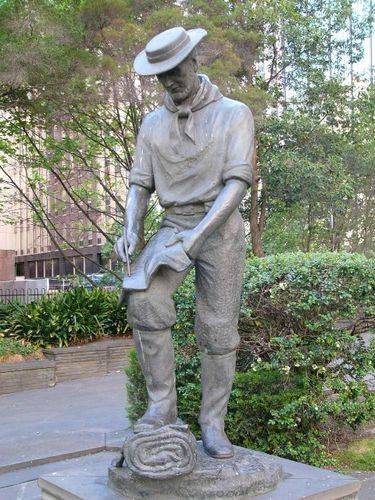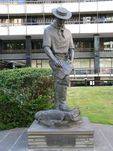
John BatmanPrint Page 
The statue commemorates John Batman (1801 – 1839), the founder of the settlement of Melbourne.
On 10 May 1835 Batman, accompanied by three European and six Aboriginal assistants sailed from Launceston for Port Phillip, where they arrived on 29 May. After a preliminary examination of the country to the west of Port Phillip Batman sailed up to near the present site of Williamstown, landed at the mouth of the Yarra, and followed it up to where it is joined by the Saltwater, now Maribyrnong, river.
He followed the course of this river for some distance in a northerly direction, and then proceeded east to the Merri Creek. There Batman met a party of aborigines and purchased about 600,000 acres of their land. Batman then made his way back to the Saltwater River and came to the Yarra on 7 June. He had intended sailing next day for Tasmania, but the wind being adverse it was decided to explore the Yarra in a boat, and fresh water was found near the present site of Melbourne Batman made the famous entry in his diary:-- "This will be the place for a village."
John Batman was a grazier, entrepreneur and explorer. He settled in the north-east of the Van Diemen`s Land Colony in the 1820s, and later as a leading member of the Port Phillip Association he led an expedition which explored the Port Phillip Bay area on the Australian mainland with a view to establishing a new settlement there. He is best known for his role in the founding of the settlement on the Yarra River which became the city of Melbourne, eventual capital of the new Colony of Victoria, and one of Australia's largest and most important cities. Batman is a controversial figure due to his dealings with Aboriginal peoples in Van Diemen's Land (Tasmania) and Victoria. The treaty Batman negotiated with local Aboriginal peoples in 1835, to acquire land in the Port Phillip area, was a matter of controversy in his day, and has remained an event of great historical interest and debate.
John Batman is widely considered to have been sympathetic towards Aboriginal people. This reputation stems largely from his famous attempt) to purchase the land around Port Phillip via a treaty with the local Wurundjeru people.
The so-called “Black War” in Tasmania gained momentum from the mid-1820s, climaxing in late 1830 with the so called “Black Line” – Australia’s largest domestic military operation prior to the defence of Darwin. Close to 400 white people were killed or wounded in this time, and probably no less than 1,000 Aborigines lost their lives in violent encounters.
Nowhere in Australia was the frontier fighting more intense, and nowhere was the Aboriginal resistance more effective. By the late 1820s, colonists were at their wit’s end. Although a great number of Aborigines were ambushed and killed around campfires, the most dangerous tribes remained vexingly elusive, and their attacks grew more frequent every day.
By this time Batman had established himself as an enterprising farmer and, having captured the infamous bushranger Matthew Brady two years earlier had gained considerable renown for his bushcraft. He was savvy and opportunistic, but also vain and adventurous. It is not surprising, then, that Batman seized on the “Aboriginal Problem” as a way to increase his holdings and inflate his reputation. His first known confrontation with the Aborigines occurred on 3rd April 1828, after his shepherd was chased off by a local tribe. The next day he discovered their campfires. The Hobart Town Courier reported the incident as follows:
“Mr. Batman hastened, creeping on his hands and feet within 20 yards of the place, before the blacks discovered him. He then endeavoured to make them stop, but to no purpose; one of them was in the act of throwing a spear at him, when he fired at him in his own defence. The man fell, but got up again and ran off. Mr. Batman then pursued them, and at last overtook a boy about 16 years of age, whom he took prisoner… [but] during the night the boy made his escape, by groping his way up the chimney.”
The following year in June, Batman petitioned Governor Arthur for the convicts and resources to form a “Roving Party” to go in pursuit of the Aborigines, conveying “the benevolent intentions of the Government.” In return, Batman wanted 2,000 acres of land after the first year, plus a reward for every “live Aborigine” brought in.
On the 5th of August 1829, Batman’s party came across a large Aboriginal camp. He and his eleven men (two of whom were “Sydney Blacks” recruited by Batman as trackers) crept as close as they could before one of them “struck his musket against that of another party, which immediately alarmed the dogs”. According to Batman’s own words, the Aborigines:
“Were in the act of running away into the thick scrub, when I ordered the men to fire upon them, which was done, and a rush by the party immediately followed, we only captured that Night one woman and a male child about Two years old, the party was in search of them the remainder of the Night, but without success, the next morning we found one man very badly wounded in his ankle and knee, shortly after we found another 10 buckshot had entered his Body, he was alive but very bad, there was a great number of traces of blood in various directions and learned from those we took that 10 men were wounded in the Body which they gave us to understand were dead or would die, and Two women in the same state had crawled away, besides a number that was shot in the legs… on Friday morning we left the place for my Farm with the two men, woman and child, but found it quite impossible that the Two former could walk, and after trying them by every means in my power, for some time, found I could not get them on. I was obliged therefore to shoot them.”
When he received the above report, Arthur scribbled anxiously on the page:
“…shoots wounded Natives because they could not keep up… has much slaughter to account for.” Two days before Batman was questioned on the matter by the Police Magistrate, he secured the capture of eleven Aborigines at Oyster Bay. He was heralded a hero and any previous indiscretions were forgotten.
Much to Batman’s frustration though, he was never able to repeat this success. He did however grow bitterly jealous of the man who was able to conciliate the Aborigines, George Augustus Robinson, taking every opportunity to undermine his rival’s efforts. While he was unquestionably a very pragmatic and determined man, Batman was by no means principled. He was often dishonest in both word and deed, and there is little evidence that his humanitarianism was any more than the rhetoric of a self-promoter.
[The Conversation, Nicholas Clements 13-May-2011]
Note :
In August 2017, prominent Australian artist Ben Quilty called for the statue to be removed calling Batman a "mass murderer." It has been removed from the site as part of the Collins Arch development. It is not known whether the statue will be returned to the site once construction is complete.
Location
| Address: | 447 Collins Street, Melbourne, 3000 |
|---|---|
| State: | VIC |
| Area: | AUS |
| GPS Coordinates: | Lat: -37.817687 Long: 144.959526 Note: GPS Coordinates are approximate. |
Details
| Monument Type: | Sculpture |
|---|---|
| Monument Theme: | People |
| Sub-Theme: | Settlement |
| Approx. Event Start Date: | 1835 |
| Approx. Event End Date: | 1835 |
| Designer: | Stanley Hammond |
Dedication
| Actual Monument Dedication Date: | Friday 26th January, 1979 |
|---|
The statues of John Batman and John Pascoe Fawkner were commissioned by Melbourne City Council and unveiled 26th January 1979








